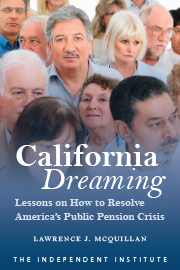The GOP debates so far have shown that the Republican presidential candidates are far from united on how best to boost the economy. Tax and regulatory reform are critical. But as a first step they should consider following the path Democrats took immediately after World War II: shrink the government.
During the war, from 1942 to 1945, the United States deployed what amounted to a centralized, command economy. The federal government diverted men and materials to the war effort using edicts and price controls, rather than allowing markets and prices to allocate resources.
New bureaucracies created to oversee the effort, including the Office of Price Administration, War Production Board, Office of Civilian Requirements, and War Manpower Commission, issued directives and enforced controls. In some cases the government actually seized companies. By 1944, government spending at all levels accounted for 55 percent of gross domestic product (GDP).
When the war ended, U.S. politicians faced a critical question: What should be done about the economy, which had been subsumed in every way by the war effort?
Paul Samuelson, a future Nobel laureate in economics, said the wartime controls should be continued, arguing that to do otherwise could trigger the “greatest period of unemployment and industrial dislocation which any economy has ever faced.” Fortunately, the Democratic-controlled Congress and President Harry S. Truman, also a Democrat, did exactly the opposite, with great success.
By 1947, government spending was reduced from 55 percent of GDP to just 16 percent. But the economic collapse Samuelson predicted never came. Instead, the sharp reduction in government ushered in one of the longest periods of economic expansion in U.S. history.
What exactly did Washington do? First, Congress disbanded all the wartime agencies that had been created. As a result, by the end of 1946 the government’s direction of resources by edict, price controls, and rationing had been essentially eliminated. Tax rates were cut as well.
As the bloated government shrank, private consumption and private investment boomed. Economist Cecil Bohanon of Ball State University has shown that personal consumption increased 22 percent between 1944 and 1947. Spending on durable goods more than doubled. Private investment jumped 223 percent; investment in residential housing increased 600 percent.
GIs also didn’t return to an “epidemic of violence” triggered by government downsizing, as another economist and future Nobel laureate, Gunnar Myrdal, had predicted. Instead, GIs returned to an expanding labor market with increased opportunities.
Between mid-1945 to mid-1947, more than 20 million Americans were separated from the military and related war jobs, while 16 million civilian jobs were created. The unemployment rate did increase—but peaked at a mere 3.9 percent. Economist Robert Higgs called this the “real miracle” of the era: “to reallocate a third of the total labor force to serving private consumers and investors in just two years.”
The prosperity of postwar America could be repeated today if Republicans would pursue the same course as postwar Democrats: Reduce the size and power of government dramatically; eliminate entire government agencies (don’t “reform” them, abolish them); and end the controls, subsidies and corporate welfare these agencies administer. It worked in 1946 and it would work now.
Government spending has ballooned to about 40 percent of GDP. It could be halved to 20 percent of GDP by reducing government spending as a share of the economy just 2.5 percentage points each year for eight years. This can be done: Postwar Democrats reduced government spending by 75 percent in just three years.
A future Republican president likely would be working with a Republican Congress in 2017, but this wouldn’t guarantee success. Scaling back government to core constitutional functions requires the courage to oppose entrenched interests and establishment elites. Democrats were up to the task after World War II. Now Republicans need to show that they are also up to the task.










